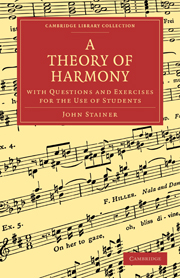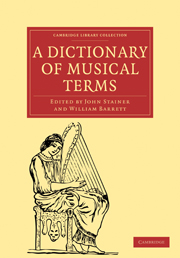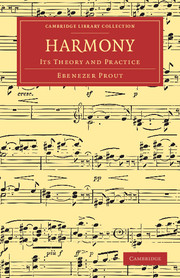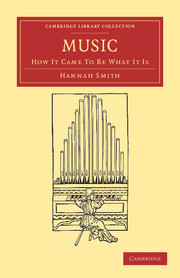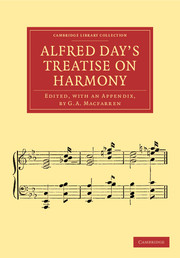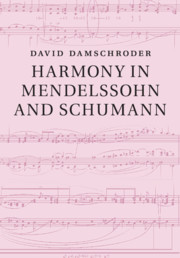A Theory of Harmony
With Questions and Exercises for the Use of Students
3rd Edition
£24.99
Part of Cambridge Library Collection - Music
- Author: John Stainer
- Date Published: September 2009
- availability: Available
- format: Paperback
- isbn: 9781108001878
£
24.99
Paperback
Looking for an inspection copy?
This title is not currently available on inspection
-
The British composer John Stainer (1840–1901) was organist at St Paul's Cathedral from 1872 to 1888, and in 1889 became Professor of Music at Oxford. In this third edition of A Theory of Harmony he ceased to call it a theory founded on the tempered scale, as he had previously. He wrote in the Preface that he now believed the theory to be perfectly applicable to the system of just intonation. A further reason, in his view, was that the attitude of scientific men toward modern chromatic music had recently improved, as they could see that their system would never be adopted as long as it threatened the existence of a single masterpiece of musical literature. However, the system would be accepted when it rendered such works capable of more perfect performance. This influential Victorian textbook is now reissued for the benefit of those interested in nineteenth-century composition and analysis.
Customer reviews
Not yet reviewed
Be the first to review
Review was not posted due to profanity
×Product details
- Edition: 3rd Edition
- Date Published: September 2009
- format: Paperback
- isbn: 9781108001878
- length: 276 pages
- dimensions: 216 x 140 x 16 mm
- weight: 0.35kg
- availability: Available
Table of Contents
1. Difference between sound and noise
2. Natural recognition of the interval of an octave
3. The material of harmony
4. Scale arranged in thirds
5. Dominant series of chords from major scale
6. Chords formed by combination of thirds from minor scale
7. Dominant series of chords formed from minor scale
8. Chords formed by a combination of notes taken from two scales
9. Relative chords are derived from the scale
10. Definition of a discord
11. Three facts accounting for many musical effects
12. Modulation
Conclusion
Appendix I Suggestions as to writing music
Appendix II Suggestions as to filling up exercises
Appendix III Figured bass
Exercises, questions and index.
Sorry, this resource is locked
Please register or sign in to request access. If you are having problems accessing these resources please email [email protected]
Register Sign in» Proceed
You are now leaving the Cambridge University Press website. Your eBook purchase and download will be completed by our partner www.ebooks.com. Please see the permission section of the www.ebooks.com catalogue page for details of the print & copy limits on our eBooks.
Continue ×Are you sure you want to delete your account?
This cannot be undone.
Thank you for your feedback which will help us improve our service.
If you requested a response, we will make sure to get back to you shortly.
×
